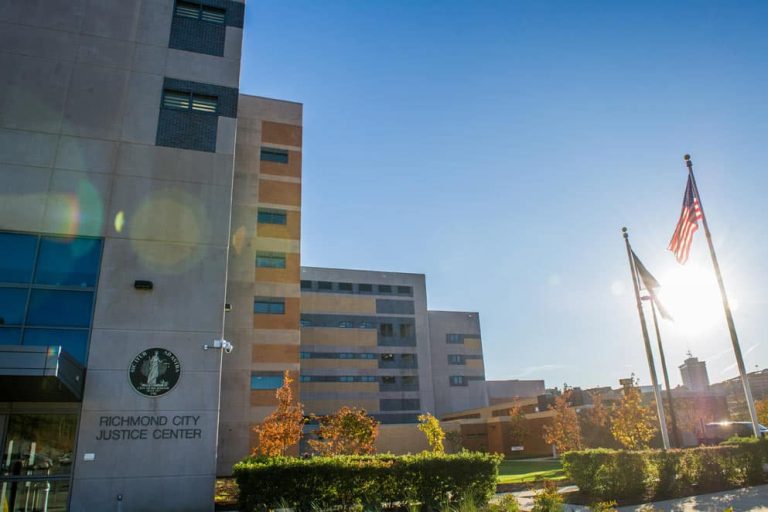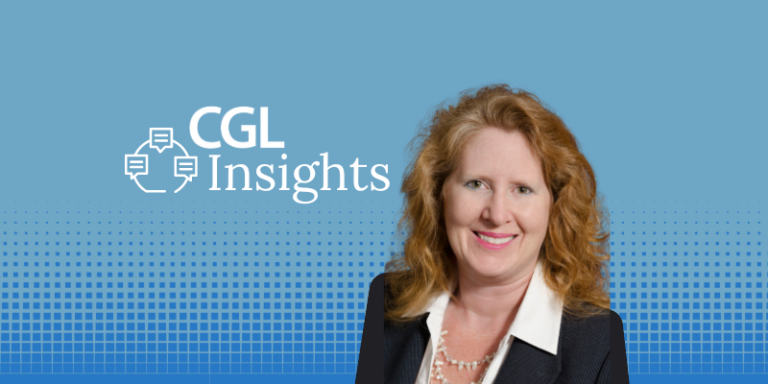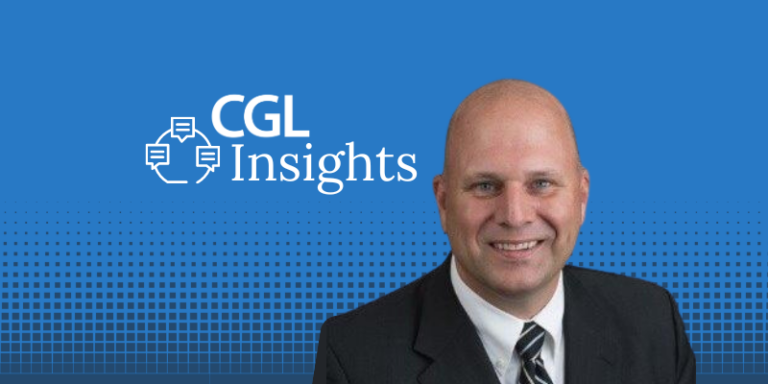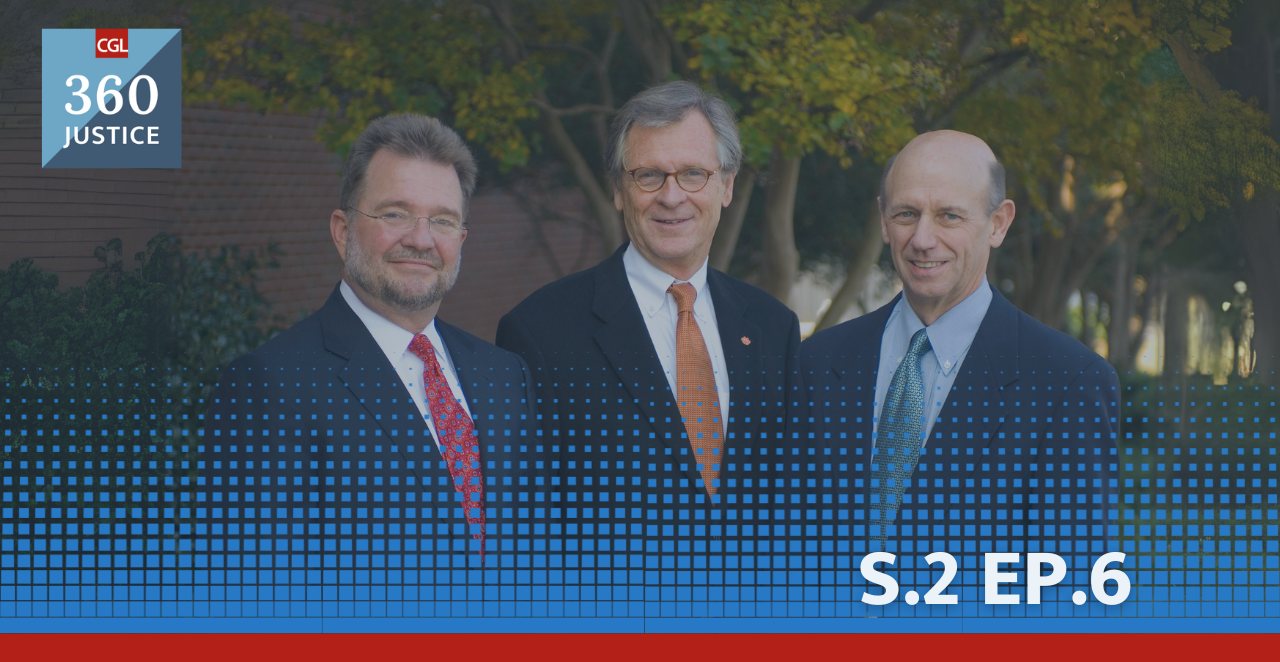
Reflecting on 50 Years: Transformative Projects that Have Shaped Our Journey in Justice
Celebrating Half a Century of Innovation and Excellence
Join host Eli Gage in a special celebratory episode of the 360 Justice Podcast as he sits down with justice pioneers Steve Carter, Bob Goble, and Joe Lee to reflect on CGL’s transformative 50-year journey. Dive into an intriguing conversation about the evolution of criminal justice—from embracing the normalization of facilities to integrating cutting-edge technology and addressing staffing challenges. Hear firsthand accounts of groundbreaking projects and learn about how CGL’s innovative strategies continue to shape justice systems worldwide. This episode is packed with insightful discussions and memorable stories that will both inform and inspire.
Meet Our Guests
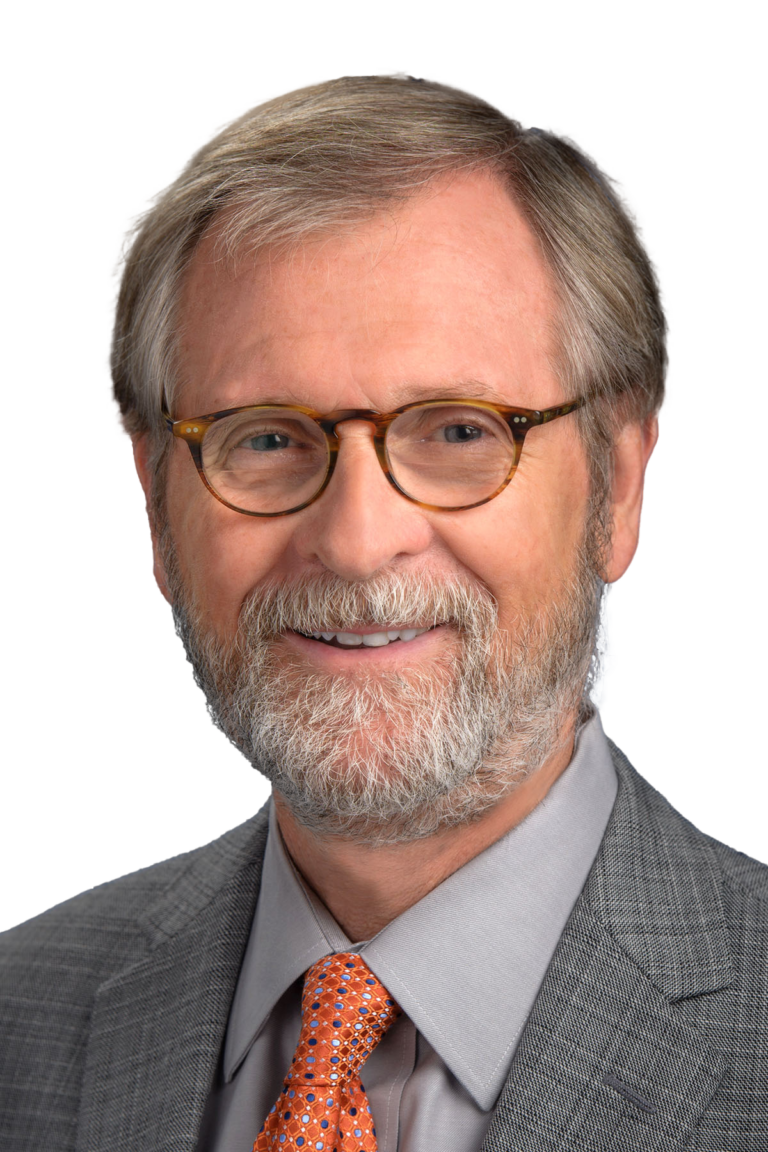
Stephen A. Carter, AICP
Stephen is personally involved in technical studies in the areas of needs assessment, operational and architectural programming, design review, program management, and policy evaluation, among others. He is often engaged by governmental agencies to develop analytically based studies and build consensus for a variety of project types ranging from courthouses to correctional institutions to law enforcement installations. His comprehensive experience in all sectors of the justice system assists clients in realizing the functional linkages between the various components.
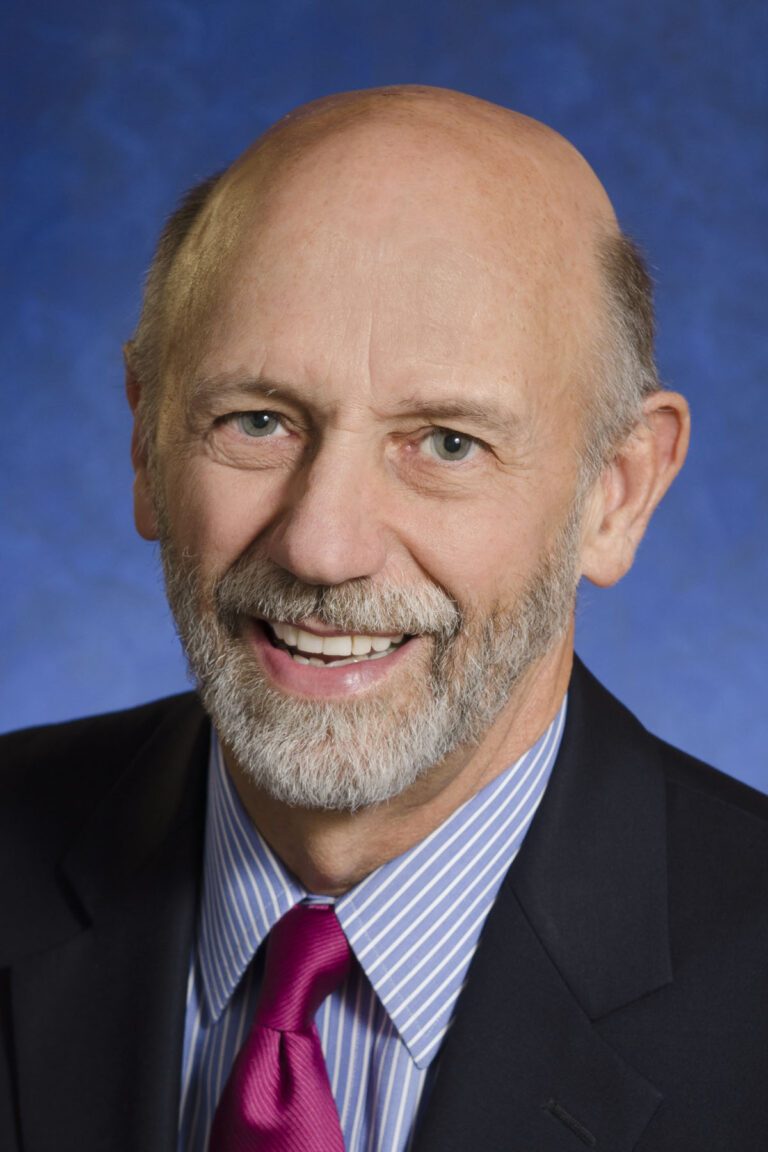
Robert T. Goble
Bob Goble is a founding Principal of CGL. A substantial amount of his experience has been in both local and state adult and juvenile criminal justice facilities planning. He has served as an expert witness in U.S. federal and state courts on behalf of both local and state governments. In addition to preparing facilities and systems plans and studies, Mr. Goble conducted a variety of operational and management systems evaluations and provided technical assistance and training programs for local officials, state agencies, governors and legislatures.
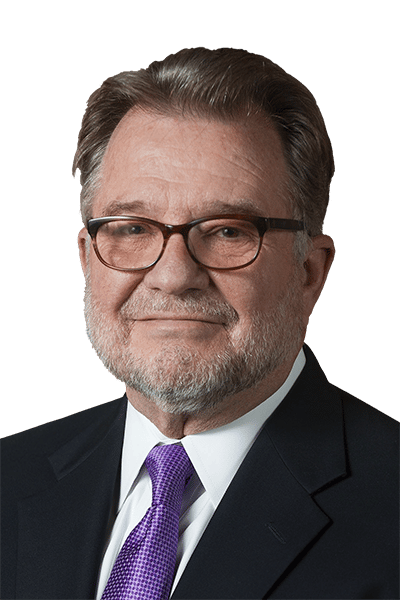
Joe E. Lee, PE
Joe’s unique understanding of justice facility operations, combined with his in-depth knowledge of justice building engineering, inspired him to give more attention to the long-term maintenance requirements of the facility. He developed the first contracted maintenance delivery system specifically designed for implementation in justice facilities. Joe’s maintenance system ensures security, prolongs the life of significant capital expenditures and lowers the operating and energy costs of the maintained facility. His system of incorporating maintenance and energy efficiencies into the planning and design of the facility can be implemented to lower the overall facility Total Cost of Ownership.
Podcast Transcript
Eli Gage: Well, hello everyone and welcome to the 360 Justice Podcast. I’m your host, Eli Gage, and I’m really looking forward today to speaking with my guests. Three national treasures of criminal justice. Actually, probably international treasures of criminal justice, Steve Carter, Bob Goble, and Joe Lee. Thanks, guys, for taking the time today.
I really appreciate it. So, Steve, I know you want to talk about the local needs and some of the projects that you’re proud of over the years. So I think I’ll just roll it off to you.
Steve Carter: Thank you, Eli.
You know that old saying of think globally and act locally? I think it applies very much to what CGL has tried to do over our 50 years in terms of the kind of things that are changing, especially since we got started in this. I am seeing a great deal more interest in the normalization of corrections.
And by that I mean that not only in the design of the facilities, but in the operations and the recognition. That we have a responsibility that goes beyond just the punitive nature of corrections, but it really does it again to embrace the fact that most of the people that we work with that we plan for that we maintain for are going to return to the community. So I’m seeing that change and I, I think it’s a very helpful and hopeful one. Another area that I would say locally that I’m seeing, and this varies by jurisdiction is a higher percentage of inmates that are more difficult to manage through the involvement of the criminal justice system partners locally.
We are seeing a lot more of the low risk offenders, not ever coming into the prisons, or if they do, they don’t stay for very long. So that’s going to change the dimensions and dynamics of corrections in the future. And can I just say one or two other things that have to do with and that is staff? Staffing is a major issue in most of the local jurisdictions that I’m working in right now.
It doesn’t matter where here or outside of the United States that both recruiting and retaining staff has become far more difficult. And we’re now moving into an age where we have Gen X People who we’re trying to engage and train and their view of a job and their view of how they would operate within a correctional environment.
I think it’s changing on that. So that’s going to continue to be a challenge that CGL is going to have to help our community. Clients chart through and, and obviously, and I’m sure others will talk about this. We’re seeing far more technology applied in our correctional facilities. You know, the traditional things of CCTV and call boxes and things like that are going to be upgraded, if not replaced by artificial intelligence solutions.
So that’s exciting. But it’s also 1 that requires a lot of preparation. So locally is a reflection of the community and the community values. And I think has been pretty good at trying to define that. And then to say, how does that change the characteristics of the facilities that we are planning? Just a quick overview.
Eli Gage: How do you plan for something like that? Steve? We had a client recently say to us when we were talking to him about kind of the upfront work and he, he actually said to me, why don’t we just build to the capacity that we can staff and I’d never heard that before and I thought to myself, well, that’s interesting. So how do you? Do you plan for what the expected is? Or, you know, to his point, can you plan for what you can staff to? Is that, is that realistic?
Steve Carter: Well, I think it probably is very realistic. It is an interesting approach to it. We used to ask clients as we started out, what is your elasticity for debt? And then we would plan for what they could afford.
I think this is another dimension of that is what can you afford for staffing and operating and what are the chances that you are going to be able to improve your recruitment and perhaps more important improve your retention. So I, I could see a day where a, a local client. Especially on the county level says, look, we don’t have a catchment area, very broad to be able to recruit staff.
So this is about the maximum number of staff. Then the way we tackle that and say, all right, then what operational methods do you want to choose? Are you talking about? A lot of remote supervision, the use of cameras, or you’re talking about direct supervision and direct involvement with the staff that would then lead us towards some planning options that we would put in front of the client and say, what do you feel most comfortable with?
And what level of training is going to be necessary to actually accomplish that?
Eli Gage: Because the numbers, the population projections, they ebb and flow and they went down and everyone was very excited by that. But now they seem to be trickling back up.
Steve Carter: COVID had a big impact as you know and a lot of systems found out they could do things that they didn’t.
Think they could do before and especially involves the judiciary. But I think we’re seeing that momentary drop in population actually increase again. I don’t think it’s going to go back to what we were experiencing a decade ago. But I do think that we are seeing that Well, I know we’re seeing rises in population, and this is very true in what I’m doing in Canada right now in the province of Alberta.
They have asked us to take a look at what’s happening if you will there. And this is not the only jurisdiction that’s beginning to say well, we’re going to have to do something about it. We’re seeing growth again. But the growth is back to what I said earlier. The growth is not in the low custody offenders.
It’s, it’s really in a higher custody offenders, which is a whole different environment, whole different staffing and staff trainings out of it
Bob Goble: Eli, if I might Steve and I, as you know, just came back from the ICPA. Annual conference in Singapore. And I think what we all saw there is a good example of what Steve started on with and what you asked the question about, can you plan on staffing?
Well, amazingly enough, Singapore has done that. Singapore has risen from what was a very punitive, borderline correction system back in the eighties to what is today at the conference we are at recognizes the most progressive. System in the world, and as a model, but all the criminologists and psychologists that were there that spoke about it talking about the incredible change they’ve gone through in bringing their correctional system from, you know, very old system was decrepit to one of the world leaders, and that goes to the point that he was making is they saw that the need for corrections is not just a confined is to really use what they call a through fair program where they take from the very first entry for the criminal justice system, that person, and they start working right away All the way through the system into transitional facilities.
Into aftercare in the community, because they got their whole nation involved in the correctional system, but to the point of planning by staff, a capability capacity. They did it, as you probably recall, we did the master planning. We led that effort for the new chain prison system that master plan and the final designs that were used.
Calls for a capacity. 20, 000 inmates on a single complex site. They built half of it. They built it, the first two of four quadrants to, to a capability of 10. They have gone down from 9, 000 some prisoners down into the 8, 000 range in the past couple of years. They said, while we were there, that staffing, as Steve indicated, not just in the US, but worldwide, is a big issue.
And that’s what they did. They were careful enough to know that the projections that they Looked to, to be able to have a site that lasted for a long, long time. Was to not build the 20, 000 because they knew they wouldn’t need 20, 000 right away to build for half of that. And it’s worked for them. It’s it saved them some of the problems that a lot of facilities or systems, I should say, how.
I’m just not having the capacity to manage the beds that they have. So. It’s a good example to us, and I think to a lot of the people that were there, Steve. The
Steve Carter: commissioner told me on Friday morning, when we were standing together in her prison to say, you know, when you started with us, we were 18, 000 inmates and now we are less than 9. But it is the community involvement. It is the alternatives. It’s looking at corrections in a different way, which I started out by saying that I think that this. Tendency towards one. Normalization and recognition that corrections has a responsibility beyond just just the confinement, but really does have a significant community responsibility to return them better than what they came into the prison system.
Eli Gage: Are they now calling this the Singapore model?
Steve Carter: We know that far just yet, but it is certainly getting picked up as Bob will knows in other countries. Now this yellow ribbon, which, by the way, started in Orlando that Bob Goble invited them to come to Orlando this back in 2004. And they are Tony Orlando seeing.
Tie a ribbon around an old tree and light bulbs just went off in their collective heads and they took that back to Singapore and it is a worldwide model right now and other countries are picking it
Eli Gage: up. How do you think that would apply in our states? How far out are we in seeing something like that?
In the United States,
Bob Goble: they saw the need for more than a secure medium and maximum prison system back in 1990, when we started working and that included, then over the 24 years, we’ve been working with Singapore, they realized they needed to build a community based facility that would be the transition of guys who work from max down to medium.
We’re in medium, but eventually then do show they’ve made the changes needed to go to, you know, minimum low custody and eventually transitional on out to the community where 95 percent or more of them are going to be. And they built that that’s what we also master plan for them. And so they have the transition.
, from the very beginning of the person’s custody all the way. Not just to the release of that person, but actually in open facilities, day reporting centers, things like that, that other people have picked up on in recent years, to where it involves the community. We’ve got the churches involved, the industries involved, the banks involved, you name it.
Bob Goble: They have all of them recognize that the vast majority of the people in prison are coming right back onto that small island. Where they better come back in a whole lot better condition.
Eli Gage: So, Steve and Bob, you guys have been super passionate about this for 50 years. Lord knows I know that. And I think a lot of people know that. What’s the outcome that, that satisfies you? I heard, Bob, you tell someone you were semi retired, but doing what you love, which is this. God’s work, what’s the outcome for you to that says, ah, we did it.
Steve Carter: me, it’s an evolving outcome. Every project I say, well, is this the last one? You know, if I can just get this 1, to a point where there has been a change. We’ve moved the needle. Maybe it’s time to hang up a cleats. And then another one comes up and say, whoa, wait a minute. There’s some unique aspects of this one that I really want to learn more about.
And so I’m finding it very difficult to completely CGO will do. But It’s just the fact that seeing over the 50 years, and this is one wonderful blessings of being able to have stayed in business as long. It would be kind of additional support that we’ve gotten out of Joe joining us and then Hunt joining us.
It has given us the opportunity to take those things that we learned way back when we did the South Carolina Department of Corrections Master Plan in 1976, and to say, look, there are some other things that are going on here that we could actually influence. And we learned some of the lessons back then, and we’re still applying those lessons.
So I, I’m, I’m just finding it very hard to say, well, this is the, the last one. So. That’s just my rambling about it, but I’m enjoying it very much. It’s a lot of work. And when you get involved on the international side, as you well know, everything from the time zones to the cultures are very, very different.
And I’m learning that through our work in the Philippines right now. You know, the the 12 hours difference is means that it’s nighttime calls or early morning calls. Bob went through that with Singapore. But we are going to make a difference in that country. It’ll be a lot better than when you know, we started on it.So I don’t know that keeps being motivating for me to want to keep at it.
Bob Goble: You know, it’s one of the joys of being in this business for me, and I know for Steve, too, that being able to be and work with people who you actually are able to help make a change in how they do things, not just. The building that they built, but even into the operations of what they do and how they think about life and the need to get prisoners to change, to bring on a whole different person that’s ready to go back into society.
And that counts for a lot. It’s what drove me into working on the twinning project. That you approved Eli back in January 22 on the rooftop in ACA Phoenix. And I’m happy to say that when you get the chance to talk with your peers. Your friend, the commissioner of the NBA that the Golden State Warriors coaches are about to sign on to take care of Solano prison for that project.
Eli Gage: That will be a pleasure to send over to him.
Bob Goble: Yeah, this is a, this is a area of work and endeavor that. I could never see totally retiring from. It’s something that just stays with you and it kind of wakes you up in the morning and it really gives you some delights when you see something positive happen in prison systems, jails, courthouses, wherever it has to do with criminal justice.
Steve Carter: Yeah, I don’t want to pile on, but I do want to give you a specific example of what we were able to do when we were working with the youth in Ontario and Canada. And by the way, we’re back in now. We’re signing the contract to do the master plan again. Up there when we were doing that, I asked him, I said, have you ever considered ensuite washrooms right in the cell?
And they said, no, not, not really. There must be a lot of operational issues. I said, Look, I, I’m doing some work in Ireland right now, and Belfast has got a youth facility that does just that. They said, well, can you bring back some evidence? Can you bring back some examples? And I did. And not only did they change their design standards to reflect all future youth facilities having ensuite washrooms, but we took that also to Nanaimo, which just opened this summer, which is overall in British Columbia, and they have incorporated it in an adult facility. So it’s those kind of things where I think CGL has really been able to move the needle by bringing examples from other Work that we have done, and it does, it keeps it keeps you motivated to see them make that change.
Eli Gage: Well, I’m gonna switch gears a little bit because I think on the justice services side of the house where you and Bob lived to the FM side of the house, 1 of the things that has made us truly unique and it’s been. By hook or crook, getting there over the last, I don’t know, Joe Lee, 20 years when CGA and lead design merged together to try to cross sell and cross pollinate in the business, it’s actually, we think, been very successful.
Joe Lee told me that he thought it was a success not long ago. He admitted that it was working because we’ve got the really smart guys on the front end doing facility and operational planning owners rep and program management and that merges into the facility maintenance and management side of the business where not a lot of companies.
In our business and maybe even in the world have that 360 justice capability. So I think you shaking your head like that, Steve, you agree. Joe is right.
Steve Carter: I absolutely agree I think we may be the only one quite frankly.
Eli Gage: Okay, you know you can retire now.
Bob Goble: Okay but you know, it’s something you learn very early on back in the 70s in the mid 70s, you need other people with other expertise in this.
You can’t do anything alone in this field of endeavor. And, you know, we, we saw that when we tried to do these master plans for South Carolina, then Arizona, that just let us leap from there nationwide. But you realize that you’ve got to have a variety of expertise at hand and able to really, totally help the client make change.
Eli Gage: Yeah, it’s nice to have it under one roof too. And I really do feel like we’ve gotten to the point where that 360 model is working my favorite example was the Richmond jail. This was years ago. I was in there. We were doing a tour. The maintenance guys were in there and we had two architects from our staff in the facility.
We were walking through and there were scuff marks all around the side of the wall where the carts were hitting the wall and the maintenance guys going, you know, we just, we can’t stop this damage from happening. One of the architects kind of said, well, why don’t you just run a piece of tracks down the wall?
And it was kind of right then where I realized, you know, that convergence of design and operational and maintenance. When that meshes together, and everybody’s firing at all cylinders, it really works. And that’s probably one of many examples, but Joe, you’ve been doing this, as I said, the father of outsourced correctional facility maintenance. I mean, Correctional News said so years ago.
Joe Lee: If Correctional News said so, and it’s got to be true. It’s got to be true. It’s like the Internet.
Eli Gage: Yeah, so I appreciate you. You’ve got some new, you’ve got some different trends, Joe, and I, and I, you know, we’re working in Alabama. It’s been a great project for us now. And I, I kept thinking Alabama, Singapore, Singapore, Alabama. Singapore model in Alabama, and I just couldn’t get my head around that. But tell us the trends you’ve seen.
Joe Lee: Well, I’ve been fortunate in my career in this business for 43 years to work with people like Paul Rosser and Steve Carter and Bob Goble, who care about making conditions better for the inmates. And in my mind, when the thought about starting this facility maintenance company came together because we were going around talking to people about new projects coming on, and they were always mad at the architect because they couldn’t maintain the facility, which I thought was accurately put on their behalf now that I’m in that maintenance business. So they’re not mad at us. Teasing. But I thought it was an opportunity to improve conditions for both the inmate and correctional officers, both in prisons and jails and actually in courts. And what we’ve seen over the years is that outsourcing that business, while nobody wanted to think it was a true business in the early days, as you will remember it became one of these things that people started saying, yeah, let’s outsource it.
We don’t want to do that. We can’t do it. We can’t hire the staff. Can’t train the staff. And then, you know, it became something that was needed in the industry, but also it became a way to give feedback back to the planners and the designers and the program managers about what was working and what wasn’t working.
And through data analytics and all the information that we’ve gathered over the last 32 years almost and and facility maintenance and in program management, you know, some of those things have really come through the roost and their facilities out there that that we have done that are in great shape that feel great to walk through and then they’re, you know, Those that are not and most of the ones that are not are ones that we’re not maintaining or we didn’t do the work for.
So it has come to full fruition that outsourcing and maintenance is a good idea after 30 or 40 years. And now, you know, I think we are positioned better in the market because of having this complete 360 degree approach to corrections and anybody else in the world. And that is coming true on some of the procurements that we go after where they’re very few people competing against us, if any, sometimes. And it’s been good.
Eli Gage: Well, Joe, you touched on something that has become kind of near and dear to your and my heart of late. And we’ve actually branded it internally called CGL Intel. It’s kind of in its infancy. But what you and Greg and the data guys from the systems and the systems of the world realized was that data mattered and the data on Steve and Bob’s side of the house matters.
And we think there may be some convergence. We could be sitting on more data than anybody else in the business. What are your thoughts on how we use that data? You and I’ve talked about it. inside a facility with sensors at a rudimentary level. But how do you see that data piece going forward?
Joe Lee: Well, being able to capture the data and use the data.
I think the phase we’re in and I’ll give you a couple of examples. When we first got into this business, there was a Utility guy Geordie Power guy and I was talking in the cost of electricity per square foot. And he said, you know, in our business in the utility business, nobody thinks of it that way.
Everybody thinks of it as cost per kilowatt hour. And so I was looking at it as more efficiency. He was looking at it for, you know, how much could be delivered to the site. So it was a total two different perspectives. So even vandalism, I mean, vandalism, if you just do the numbers on vandalism, you can tell a well run facility, a well operated facility by the amount of vandalism that’s going on.
So that’s one data point. Okay, the other data point is, of course, the cleanliness of the facility, and that’s a visual thing, but I think it’s some information that we start needing to develop from an intel standpoint of view. And then if we really use sensors to their ultimate degree, we could actually determine the mood of the inmates in the correctional facilities and whether they’re under stress or not, just through sensors, that would also tell us something.
It tells us how big to make the living unit, how small to make the living unit, whether individual sales was better than sales or multi person dorms. And especially in this day and time when the inmate population has become more violent and inmate population that are being incarcerated are more intense than when we first started.
And if you look at, for example, Alabama system. Until we get this new one completed, we have 18 percent cell beds and 82 percent dorm beds. And if somebody were to measure the violent events on that system versus Singapore, for example, then there might be some telling data there that would bring us to some conclusions here in the United States that will be so evident that people can argue against it.
Eli Gage: All right, I was going to ask all three of you guys top three favorite projects, but I’m not going to say it that way. I’m going to ask you, Joe, top three most memorable projects.
Joe Lee: Well, Forsyth County, Georgia was one that was the only facility that Steve and Bob and I worked on together in the entire, you think about, I’ve known Steve first met Steve in 82’, I think, so I’ve known him for 42 years, and we worked on one project with all three of us. That’s hilarious. What I did learn and give these guys credit is that, you know, they had enough time to go to the bathroom when they got to the airport at the end of the day from having all day meetings to go to the next meeting they were gonna have and the next city they were gonna have all day long. So, you know, the hard work that we put in into this business for the last 30 to 50 years has been enormous.
Steve Carter: It’s a hard question for me Eli, because I really have enjoyed virtually all of them that I’ve worked on. But I would say the three that I will always remember as being unique to what we’re doing, the Las Colinas Women’s Facility gave us an opportunity after So Working with them for 10 years to actually arrive at something for women that I think did help not only the county move the needle, but has been an influence in the in the U.S. and outside of the U. S. So that that was one. Another one I have to say has nothing to do with corrections. Was the U.S. House of Representatives master plan to be able to interview a large number of the House members and have them tell me what their vision was and then how we could respond spatially to help them and help us have a more efficient government was was really quite a memorable experience.
So I’ll say the last one was the Johnson County courthouse that. Also was a 10 year in the workings before it ever was realized. And I really did get to be involved with community leaders, with the leaders on the judicial side and, and that one resulted, as we all know, in a a really quite a good new courthouse that where we broke some ground on that.
I mean, those are just three Could ramble on forever, but, but those are 3 that are highly memorable for me, the people that we work with. And in all instances, it was the client building and feeling trust with us and the advice that we were giving. And that’s really, at the end of the day, what it’s all about is that your client trust you enough to take your recommendations, even though sometimes the idea of having an ensuite bathroom just, It is not on for them, but they trust you enough to say, well, if you can show us why and how, then that we’ll consider it. So that’s great. Great benefit in this in this business to see that kind of response,
Eli Gage: Bob, I’ll come back to you in one second because Steve brought up something that I want to point out.
Joe Lee: I only got one in, by the way.
Eli Gage: We can come back to you, too. But, but Steve said something about I’ve been working with them for merely 10 years. My son actually asked me 1 time recently, he said, how long you’ve been working there, dad? And I said, God, you know, 20 years. And I don’t think people realize how long we have clients, you know, which is the ultimate goal: clients for life. It goes back to that 360 model. Hawaii. I’m going to Hawaii next week for the women’s community correctional center ribbon cutting after four years. And that was a kind of a classic CGL project that started as master plan. Steve, way back. Yeah, it was way back.
Steve Carter: That one.
Eli Gage: Way back when, go ahead, Bob. You know the dates off the top of your head
Bob Goble: Well I was going to use Hawaii as one of them because it started by Steve Carter getting involved in an activation consultancy for I think through NIC and that.
Steve Carter: Yeah, it was.
Bob Goble: It was 84’, 1984. But from that really unusual start, it really turned into something because not only did we get to do a lot of planning work that, you know, put bread on the table for a while, but it led to Joe Lee and the whole idea of FM eventually coming in.
It got the attention of the client that we started with there and, and as you were just talking, Eli, it really led to a whole great opportunity, there were just some unforgettable things, some unforgettable people to be honest. George Sumner was the acting director at the time we started under for master planning, well, I’m sorry, Kip Katsky started it, but then George came in and Kip actually recruited him. We sent Rusty Deckerson and his wife from Texas to Hawaii to be in residence there because George said, I need answers by the opening of the legislature this year on how much we got to spend. We got it done, but there was some unusual things going on in Hawaii back then.
But at any rate, that’s one of them. The other one is Singapore. It’ll always be at the very top of my list because we were the lead planner on five facilities there and started with new Changi prison went to the subordinate courts expansion planning again with the local architects that started out in public works and became a private operation.
After a while, they privatized the whole division. We work with them. We did the new juvenile boys’ home. We’d call it a detention center. We did the programming for the Supreme Court building with the local architect, which eventually went to Sir Norman Foster from England, one of the great architects of our time, who designed that building.
Our program was what was used by him. And then finally, the Celerine Park complex there, that, that was kind of the cap for us, to be able to give the far end of the correction system got transitional capability to get people back to community. My third one was a short one. It was the ADB, the Asian Development Bank World Headquarters in Manila expansion plans.
The first expansion plan, they said, we’ve got politics that won’t let us build what we had master planned to build for expansion, but we’ve got to fit another 150 staff in next year. So, Anders Kaufman, one of our architects and I went over and we figured out how to use and repurpose existing space and it worked for five years.
They called us back in five years. They said, you guys can figure out how to justify expanding this now to the Skidmore Owings and Merrill master plan. Which was a fine design, a great master plan and they had the space saved like Singapore saved their space. And so it was not hard for us to come back after having saved their bacon on having to bring 150 new staff in without adding space.
But this time it had reached incredible growth and he needed, finally, and we justified the building and they got it built. The expansion that has to win the design. Those are my three.
Eli Gage: Okay, glad I limited you to three.
Bob Goble: Yes.
Joe Lee: Well, you know that our average clients that come back to us is 85%, right? You’ve seen that stat.
So, 85 percent of our clients come back and use us more times than just one. So speaking of one, which was the British Columbia projects I worked on. Those were memorable from the standpoint that I remember this one day I was touring one of their jails, and I looked around and I watched the inmates and I watched what was going on. And I said, you guys have a better class of inmates than we do in the United States. There’s just no doubt about it. They’re nicer. They’re more polite. And they don’t vandalize, and then they automatically all turned, and they started, every time I’d come in the room now, they’d go, Oh, it’s Joe, the jail guy from Georgia.
So that was my name in British Columbia, was Joe the jail guy from Georgia. The other one, the other memory that I have that will always stick in my head is one where we did not get the project. But we were working on the planning services and we sat in a meeting and the sheriff was, this was in actually North Georgia, the sheriff was about to make a big mistake and Bob was on his way to the airport to another client to another meeting and I was going home and Bob and I were talking about it on the phone and he said, you know what, we just can’t let him make that mistake.
I’m turning around and going to meet with him. And Bob turned around and went back to the city we were working in to convince the guy not to make the mistake. And if we can have that kind of client dedication across the board at CGL, we’ll be at 500 million in a couple years.
Bob Goble: That’s one of Joe’s famous fables. It goes from South Georgia to North Georgia.
Eli Gage: That’s right. Well, that reminds me, Joe, of a project you and I were working on. And we were at a pivotal point, and you called me up and we had to make a decision and you said, we’re too old to do the wrong thing. And that kind of set the tone of which direction we went and it was accurate.
All right, well, listen, I’m going to wrap this up and without making me cry, is there anything that you three would like to say to one another? Joe, you go first. I can see you the easiest. Joe is weeping already. Don’t make me cry, please.
Joe Lee: Well Steve Carter texted me the other day and asked me, in retrospect, would I do it all over again? And I said, yes, and twice on Sundays. It has been an honor to work at CGL and to build what we have built.
Eli Gage: Well said. Steve, you’re up.
Steve Carter: Well, I you know, it’s hard to say that you really were as bright as you thought you were in choosing the people that you wanted to have around you. But you know, you’re going to spend, and I have spent, four more times with Bob Goble than I probably have with my wife over the years and so there’s got to be a chemistry.
There’s got to be a respect. And then we, we added Joe to the mix and then he was just a perfect addition to the integrity that Bob and I thought was so important. And Joe just gave an example of Bob turning around and coming back and saying wait a minute. We got to get this right. Side of it. So, yeah, it’s been an incredible run. You know, Bob theoretically retired but he’s not. We talk very regularly, virtually every day. And Joe, I know that I can call on him as I did recently and as I’m going to do later today about something in the Philippines. It’s having that kind of connection, that kind of chemistry, and frankly, that kind of love that has really, really made my career one that I don’t think will be duplicated.
Eli Gage: I would agree with that. Bob Goble.
Bob Goble: I feel like the luckiest one because I had a career in, in something that I never had dreamed up that I always had thought of being a government employee, but then the opportunity came by a spark connection from Steve Carter to Frank Roberts to me that got me to make a change away from government to working in the private sector.
And I’ll always thank both of you guys for it. And you too, Eli. Joe, you made it a whole lot more successful than we had been. And it was just a great decision to come together. And there’s no company like it in the world, period.
Eli Gage: Agreed. Well, I need you guys to get back to work. Yes. So I’m going to wrap it up here. Does anybody have anything they’d like to add in addition?
Steve Carter: Well, thanks to you Eli for bringing Hunt to us that allowed us to perhaps reach a bit further than what we thought we could and your relationship there and continued relationship and nurturing that. That’s why I think Joe’s right. We’ll hit a half a billion.
Eli Gage: Yes we will. Now it’s on a podcast. It’s, it’s in. Well, thank you everyone for listening to our podcast today. You can find this and other episodes on the standard podcast platforms, Apple podcast, Spotify, Amazon, or visit us at CGLcompanies.com/podcast.
Thank you guys for your time today. Appreciate it.





